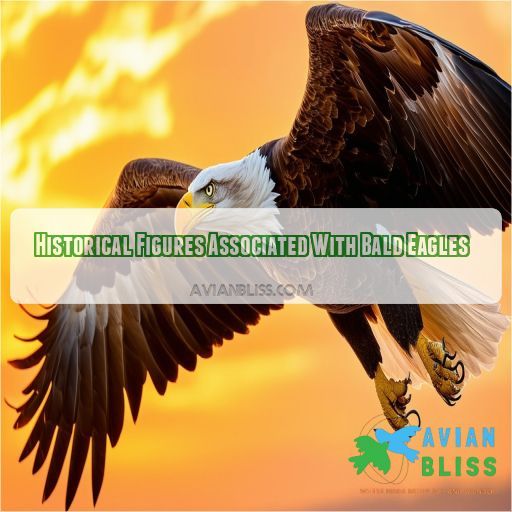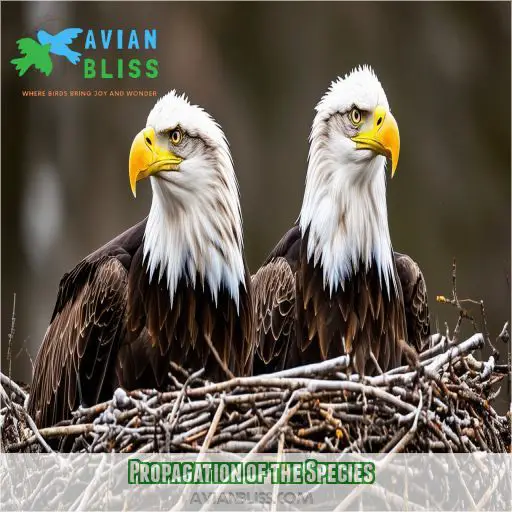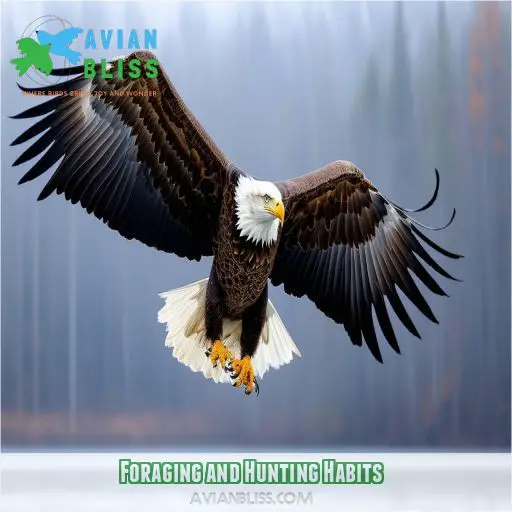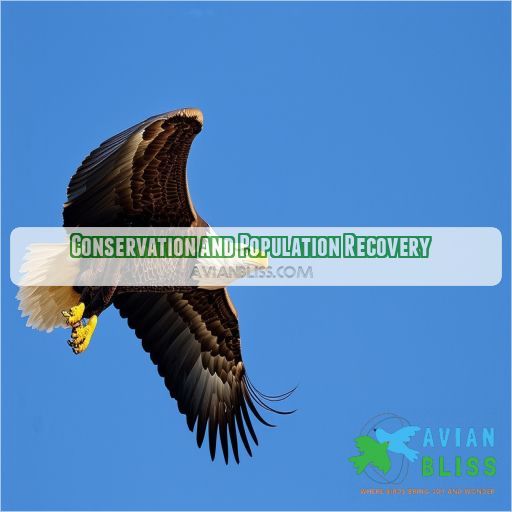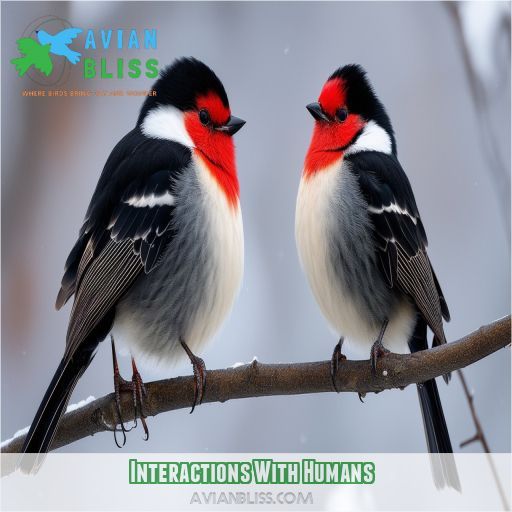This site is supported by our readers. We may earn a commission, at no cost to you, if you purchase through links.

This powerful bird of prey has captured the imagination of many. How much do you really know about this iconic species?
From their symbolic significance to their unique habits and impressive skills. There’s more to these eagles than meets the eye.
Get ready to explore. Ten fascinating facts about bald eagles. That will leave you in awe of their beauty, strength, and resilience.
Table Of Contents
- Key Takeaways
- The Bald Eagle’s Symbolic Significance
- Historical Figures Associated With Bald Eagles
- Unique Physical Characteristics
- Propagation of the Species
- Remarkable Nesting Behaviors
- Foraging and Hunting Habits
- Impressive Abilities and Skills
- Conservation and Population Recovery
- Interactions With Humans
- Myths and Misconceptions
- Frequently Asked Questions (FAQs)
- Conclusion
Key Takeaways
- Bald eagles embody freedom, strength, and resilience in North America.
- Their population’s recovery testifies to the power of conservation efforts and nature’s resilience.
- They are impressive hunters, showcasing their skills in the air and water, and they are not above stealing food from other birds.
- Beyond their symbolic significance, bald eagles have a special relationship with humans, featuring in cultural depictions and engaging in playful behaviors.
The Bald Eagle’s Symbolic Significance
The bald eagle is a powerful symbol of freedom and patriotism in the United States. It officially became the national symbol in 1782.
Its iconic status is reflected in the country’s emblem and currency, among other representations.
Revered by Native Americans, the bald eagle represents strength, courage, and spiritual connection.
Beyond patriotism, the bald eagle is a symbol of conservation. The species recovered from near-extinction thanks to the ban on DDT.
Benjamin Franklin once proposed the wild turkey as the national bird, but the bald eagle’s enduring appeal won out.
Historical Figures Associated With Bald Eagles
The bald eagle has been a powerful symbol for centuries, and its historical significance is closely tied to notable figures who recognized its importance. Serving as the national emblem of the United States since 1782, the bald eagle’s association with freedom and strength made it a natural choice to represent the emerging nation.
The Founding Fathers, including Benjamin Franklin, played a pivotal role in shaping the bald eagle’s status. Franklin initially proposed the wild turkey as the national bird, but the bald eagle ultimately prevailed, embodying the ideals of courage and liberty that the young country cherished. This majestic bird, with its distinctive white head and impressive stature as the largest North American bird of prey, became an enduring symbol of American identity and pride.
Unique Physical Characteristics
Bald eagles are North America’s largest birds of prey, weighing between 8.1 and 12 pounds and boasting a wingspan of up to 92 inches. Their impressive size is complemented by exceptional eyesight, approximately 4-5 times sharper than humans’. This keen vision, coupled with a strongly hooked beak and sharp talons, makes them formidable hunters.
Their habitat reflects a preference for seclusion, typically residing near large bodies of water and tall trees, maintaining a distance of at least 1.2 km from human settlements.
Propagation of the Species
Bald eagles are monogamous, mating for life.
They display commitment through impressive aerial displays, with both partners soaring and diving in unison.
These birds of prey share responsibilities, building nests, incubating eggs, and caring for fledglings.
Typically, the female lays 1-3 eggs per season, and both parents take turns incubating, ensuring the survival of their young.
This level of parental cooperation contributes to the healthy population of bald eagles today.
Remarkable Nesting Behaviors
Bald eagles showcase extraordinary nesting behaviors that reflect their unique qualities and adaptations, especially in their nest building process. They’re renowned for their precise nest construction, often building enormous nests** high in tall trees. These nests, constructed from twigs and branches, can measure up to 9.5 feet in diameter and 20 feet deep, setting a record for the largest tree nest.
Bald eagles display territorial aggression during the breeding season, aggressively defending their chosen nest sites. They demonstrate pair bonding, with males and females collaborating in nest-building and protection. This teamwork extends to parenting, as they share the duties of incubating eggs and rearing their young.
Nest site selection is of paramount importance to bald eagles. They favor locations within close proximity to water bodies, facilitating easy access to their preferred seafood diet. To safeguard the well-being of their offspring, bald eagles tend to avoid human habitations, opting for secluded areas far from populated regions. This extensive habitat requirement reflects their need for ample space and privacy during the critical nesting and fledging stages.
Foraging and Hunting Habits
Bald eagles are skilled hunters and opportunistic foragers with a varied diet. They primarily feed on fish, but their nomadic years and adaptability to food availability make them versatile predators.
- Nomadic Years: During their first four years, young eagles explore vast territories, honing their hunting skills and learning to adapt to different food sources.
- Versatile Diet: While fish is their primary food source, they also prey on waterfowl, small mammals, and even large birds like Canada geese.
- Kleptoparasitism: Bald eagles occasionally steal food from other birds, showcasing their intelligence and adaptability to survive.
Impressive Abilities and Skills
Bald eagles are incredibly skilled hunters and fliers, with a range of abilities that showcase their power and mastery in the air and water. They can soar for long distances, reaching speeds of up to 30 mph, and have exceptional eyesight—approximately 4-5 times better than humans. This makes them formidable hunters, capable of spotting prey from great distances.
| Ability | Description |
|---|---|
| Speed | Can reach speeds of 160 kph (99 mph) when diving. |
| Diving | Dive at incredible speeds to catch fish, showcasing precision and agility. |
| Fishing | Skilled fishers, often timing their feeding with salmon spawning. |
| Soaring | Capable of soaring for long distances, conserving energy during migration. |
Bald eagles aren’t limited to hunting fish, and will also prey upon small mammals and other birds, demonstrating their adaptability and versatility as hunters. They’re powerful, agile, and highly skilled, making them impressive predators in the wild.
Conservation and Population Recovery
Bald eagles were once endangered due to DDT poisoning.
Thanks to conservation efforts, their populations are recovering.
The ban on DDT and habitat protection have been essential in this turnaround.
While lead poisoning from contaminated carcasses remains a threat, the future outlook is optimistic.
The population has rebounded from just 400 pairs in the US in 1963 to over 300,000 in the lower 48 states today.
This recovery showcases the positive impact of dedicated conservation initiatives.
Interactions With Humans
Now that we’ve explored the conservation efforts and population recovery of bald eagles, let’s turn our attention to the fascinating interactions between these majestic birds and humans. Bald eagles have had a variety of relationships with people, from cultural depictions to environmental stewardship.
Humans have had a significant impact on bald eagles, both positively and negatively. On the one hand, bald eagles were once endangered due to DDT poisoning, but protective laws and conservation efforts have helped their populations recover. Today, they’re a symbol of environmental stewardship and freedom.
Eagle tourism is also a growing industry, with people travelling to eagle hotspots to catch a glimpse of these majestic birds in their natural habitat. In captivity, bald eagles are known to interact with humans, and some even participate in educational programs to raise awareness about their species.
Bald eagles have left an indelible mark on human culture as well. They’ve been revered and respected by various indigenous groups for centuries and have become a prominent symbol in American culture, representing strength, courage, and freedom.
Myths and Misconceptions
Despite being a symbol of strength and freedom, the bald eagle has been the subject of various myths and misconceptions. Here are three facts to set the record straight:
- Bald eagles aren’t actually bald; they’ve white feathers on their heads, contrasting with their dark-brown body feathers.
- While majestic and powerful, they’re not picky eaters. They’ve a varied diet, feeding on over 400 prey species.
- They’re highly skilled hunters, reaching 160 kph (99 mph) when diving for prey. They’re not lazy or sluggish.
Frequently Asked Questions (FAQs)
What are 10 interesting facts about bald eagles?
- Bald eagles are the largest bird of prey in North America, known for their impressive hunting habits
.
- They weigh between 1 and 12 lbs and have a wingspan of up to 92 inches.
- Bald eagles mate for life.
- They build the largest tree nests, with a record diameter of 5 ft and a depth of 20 ft.
- Young eagles spend their first four years exploring.
- Bald eagles were once endangered due to DDT poisoning, but their populations are now recovering.
- They’re protected by the Bald and Golden Eagle Protection Act.
- Bald eagles are skilled swimmers and divers.
- They live up to 20 years in the wild and over 30 years in captivity.
- These birds are playful and have been known to use plastic bottles as toys.
What is unique about eagles?
Eagles are birds of prey with a unique hunting strategy. They don’t surrender to prey larger than themselves and will attack to protect their territory. Bald eagles are only found in North America.
What are some fun facts about bald eagle nests?
Bald eagles build the largest nests of any bird species. One found in St. Petersburg, Florida, measured 5 feet in diameter, 20 feet deep, and weighed almost 6,000 lbs. They also keep greenery around their nests, possibly to repel insects.
What is the bald eagle most known for?
A bird in the hand is worth two in the bush. The bald eagle is most known for being the national symbol of the United States, but it’s also famous for its hunting prowess. They swoop down on fish, snatching them with their talons.
How common are bald eagles?
Bald eagles are now common in the United States, with a population of over 300,000 in the lower 48 states as of The population has quadrupled since
What do their nests look like?
Imagine a nest so large it can weigh over 1,000 pounds, constructed with large sticks and lined with moss, grass, plant stalks, lichen, seaweed, or sod. This is the kind of nest that bald eagles build, usually in the tallest trees around, with a commanding view of the surrounding terrain and water.
Do they live in flocks?
Bald eagles usually fly alone, but it’s not uncommon to see small flocks of 5 to 20 birds during winter migrations. In some places, you might see groups of 10 or more eagles.
How often do they eat?
Bald eagles eat between 5 and 5 pounds of food per day. This is the equivalent of 6 to 1 pound of food per day for a 10-pound eagle.
What is their migration pattern?
Bald eagles have complex migration patterns that depend on age, breeding location, and food availability. In the fall, adult eagles migrate coastward or to open water when lakes and rivers freeze, returning to their breeding grounds when food is available, usually from January to March. Juvenile eagles migrate north, while adults don’t migrate with them.
Conclusion
Soaring alongside a bald eagle, you’ve explored ten fascinating facts about these majestic birds.
From their symbolic significance to unique habits and skills, you’ve examined their history, characteristics, and nesting habits.
You’ve also learned about their interactions with humans, showcasing the bald eagle’s resilience and strength.
Now, you can appreciate these iconic birds with a deeper understanding of their beauty, power, and essential role in nature’s landscapes.


